FGVminiATURES TM
eBayBasic Miniature Vase Turning
The purpose of this article is to introduce the woodturning methods peculiar to miniature vases. No attempt is made to teach basic woodturning, tool usage, or sharpening - it is assumed you already have those skills.
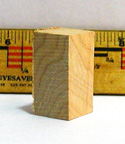 Our starting point will be a 3/4 in. square block 1 1/2 in. long. This is the basic size I use for turning miniatures; I can make a vase, 2 or 3 bowls, or a vase and a bowl from one of these blanks. (For this article, I will be using the bottom third of a maple blank from which a vase has already been turned.)
Our starting point will be a 3/4 in. square block 1 1/2 in. long. This is the basic size I use for turning miniatures; I can make a vase, 2 or 3 bowls, or a vase and a bowl from one of these blanks. (For this article, I will be using the bottom third of a maple blank from which a vase has already been turned.)
Since miniatures don't incur as much stress as full size turnings, you can attach them with CA glue to a waste block and chuck the two pieces using a scroll chuck (a screw chuck will also work). I favor the use of waste blocks because they are cheap, easy to make, allow you to use all of your blank, and they provide a method for accurate rechucking.
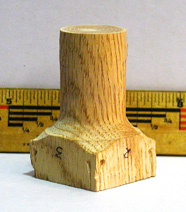 The waste block used in this example is a piece of Oak 1 1/2 inches square and about 3 in. long (easily made from a 2x4, 2x6, etc.). It has been turned round for about 75% of its length, leaving 1/2" to 1" square on one end to be gripped by the chuck. The block doesn't have to be Oak, but it should definitely be a hardwood, as the jaw pressure from the scroll chuck will deform the corners.
The waste block used in this example is a piece of Oak 1 1/2 inches square and about 3 in. long (easily made from a 2x4, 2x6, etc.). It has been turned round for about 75% of its length, leaving 1/2" to 1" square on one end to be gripped by the chuck. The block doesn't have to be Oak, but it should definitely be a hardwood, as the jaw pressure from the scroll chuck will deform the corners.
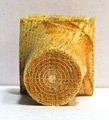 Note that concentric circles have been cut into the end of the waste block. These circles help center the blank and also create glue channels which help hold it. The circles were cut with the tip of a skew chisel.
Note that concentric circles have been cut into the end of the waste block. These circles help center the blank and also create glue channels which help hold it. The circles were cut with the tip of a skew chisel.
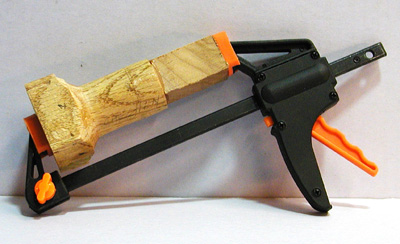 Attach the blank to the end of the waste block using thick CA glue. Clamp and set aside for at least an hour before you begin turning. You could use accelerator and start turning right away, but if the glue isn't thoroughly set underneath the blank you could knock it off as you are roughing it down. This usually results in some unnecessary down time for repairs.
Attach the blank to the end of the waste block using thick CA glue. Clamp and set aside for at least an hour before you begin turning. You could use accelerator and start turning right away, but if the glue isn't thoroughly set underneath the blank you could knock it off as you are roughing it down. This usually results in some unnecessary down time for repairs.
 When mounting in a scroll chuck, mark the sides of the waste block to correspond with the jaw numbers on the chuck. This will make the assembly easy to reposition accurately later for sanding, oiling, finishing, whatever. I usually keep 6 of these assemblies going at a time. This allows me to work on one piece while the finish is setting up on the other(s).
When mounting in a scroll chuck, mark the sides of the waste block to correspond with the jaw numbers on the chuck. This will make the assembly easy to reposition accurately later for sanding, oiling, finishing, whatever. I usually keep 6 of these assemblies going at a time. This allows me to work on one piece while the finish is setting up on the other(s).
If you don't have a scroll chuck, a screw chuck will work just as well.
 The first thing you have to do is round the blank off. You can use either a very sharp spindle gouge or a bowl gouge. The main thing is to get a clean cut by the time you have the blank down to its final size.
The first thing you have to do is round the blank off. You can use either a very sharp spindle gouge or a bowl gouge. The main thing is to get a clean cut by the time you have the blank down to its final size.
Next, establish the outside shape using a sharp bowl gouge and/or a skew. If you must 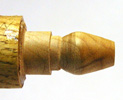 use a scraper, angle it for a shearing cut; a straight scraping cut will leave the surface rough enough that you may have to significantly reduce the diameter or alter the shape to get it smooth. In large turnings this problem is insignificant; in miniatures you can lose your basic shape at the outset by leaving too rough a surface.
use a scraper, angle it for a shearing cut; a straight scraping cut will leave the surface rough enough that you may have to significantly reduce the diameter or alter the shape to get it smooth. In large turnings this problem is insignificant; in miniatures you can lose your basic shape at the outset by leaving too rough a surface.
 Sand and finish the outside. Despite what many "purists" would say, I think sandpaper is an acceptable shaping tool - especially in miniatures. After sanding to at least 600 grit, you can put on a coat of Walnut oil - or any other oil, for that matter - to "pop out" the grain of lighter woods like maple, if you like. (If you compare wood that has been oiled to that which has not, you will find that the oil generally accentuates the grain, but also makes the wood appear a little darker and slightly yellowish.) Oil will have little or no effect on darker woods. When the oil is dry, buff with 600 to 1000 grit and add the finish of your choice.
Sand and finish the outside. Despite what many "purists" would say, I think sandpaper is an acceptable shaping tool - especially in miniatures. After sanding to at least 600 grit, you can put on a coat of Walnut oil - or any other oil, for that matter - to "pop out" the grain of lighter woods like maple, if you like. (If you compare wood that has been oiled to that which has not, you will find that the oil generally accentuates the grain, but also makes the wood appear a little darker and slightly yellowish.) Oil will have little or no effect on darker woods. When the oil is dry, buff with 600 to 1000 grit and add the finish of your choice.
 Hollowing is much easier if you first drill a hole a little smaller than the final inside diameter at the rim, and a little shallower than the final desired depth. It is important that both the tailstock and the Jacob's chuck are tightened firmly - any wobble at this point can make a real mess of the rim of your vase. (Some turners drill the starter hole just holding the drill in their hand and steadying it on the tool rest. I don't recommend this for miniatures, as you have very little margin for error.) Mark the drill for the proper depth. Here is where you definitely want to err on the light side - you can always make the hole deeper, but if you go too far you will end up nothing but a large bead.
Hollowing is much easier if you first drill a hole a little smaller than the final inside diameter at the rim, and a little shallower than the final desired depth. It is important that both the tailstock and the Jacob's chuck are tightened firmly - any wobble at this point can make a real mess of the rim of your vase. (Some turners drill the starter hole just holding the drill in their hand and steadying it on the tool rest. I don't recommend this for miniatures, as you have very little margin for error.) Mark the drill for the proper depth. Here is where you definitely want to err on the light side - you can always make the hole deeper, but if you go too far you will end up nothing but a large bead.
 The drilling will go much easier, and be less prone to error, if you first make a starter hole in the center of the bowl with the point of a skew.
The drilling will go much easier, and be less prone to error, if you first make a starter hole in the center of the bowl with the point of a skew.
 How much hollowing you do is strictly a matter of personal preference. I generally try to hollow out miniature vessels to the same degree that I would in a full size turning. Remember, if you only have a hole from top to bottom, it is technically a bud vase. A true vase (or urn, or hollow form, or whatever) should be fully hollowed out.
How much hollowing you do is strictly a matter of personal preference. I generally try to hollow out miniature vessels to the same degree that I would in a full size turning. Remember, if you only have a hole from top to bottom, it is technically a bud vase. A true vase (or urn, or hollow form, or whatever) should be fully hollowed out.
 I use a variety of tools for hollowing that I make from picks and small screwdrivers. In the photo, the first two tools are made from screwdrivers, the others are made from picks. The plain rounded end (second from left) is the the only one I use for bowls; I use all of these for vases and other hollow forms. They all function as scrapers, and how much bend you need is determined by the shape of the vessel.
I use a variety of tools for hollowing that I make from picks and small screwdrivers. In the photo, the first two tools are made from screwdrivers, the others are made from picks. The plain rounded end (second from left) is the the only one I use for bowls; I use all of these for vases and other hollow forms. They all function as scrapers, and how much bend you need is determined by the shape of the vessel.
The critical points when hollowing a vessel are the rim, the wall thickness, and the depth. (Which pretty much covers the whole vessel.) You have to take care at the rim that you don't destroy the edge. It helps to use a parting tool or the point of a skew to establish the rim thickness before using the other hollowing tools. The wall thickness you have to pretty much gauge by eye in miniatures, as you can't very well get calipers inside these small vessels, but it is generally pretty easy to do. The depth we took care of when drilling; all we have to do now is be careful when rounding the inside at the bottom not to go too much further.
 Once the inside is shaped, sand it smooth at least as far inside as you can see, and finish just like the outside. Then part off the bowl from the waste block and finish the bottom.
Once the inside is shaped, sand it smooth at least as far inside as you can see, and finish just like the outside. Then part off the bowl from the waste block and finish the bottom.
 Note that we still have almost a third of the blank left after the finished vase is parted off. This will be used to make the bowl in theFGVminiATURESTM Basic Miniature Bowl Turning article.
Note that we still have almost a third of the blank left after the finished vase is parted off. This will be used to make the bowl in theFGVminiATURESTM Basic Miniature Bowl Turning article.